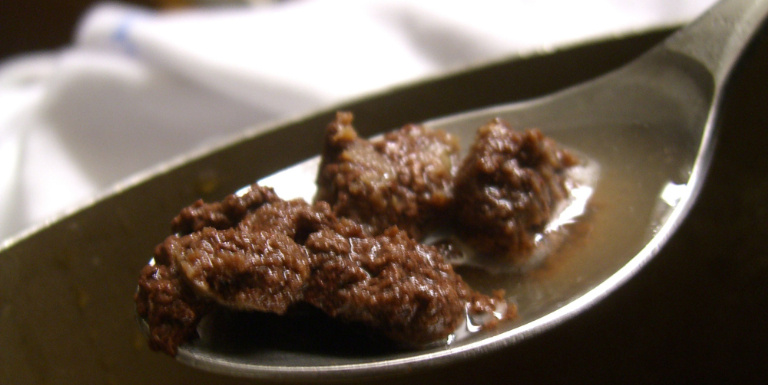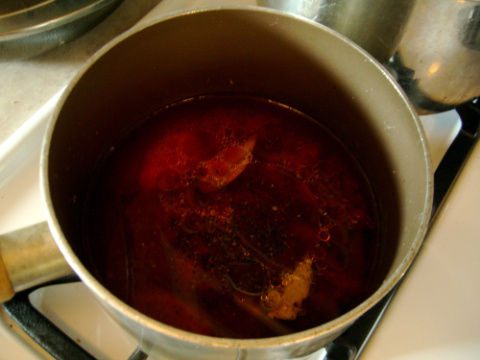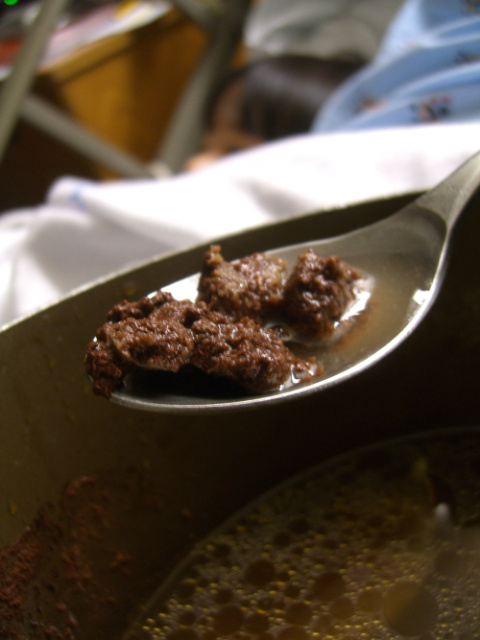
I stared at the crimson-colored organ sealed in industrial-strength Tupperware and labeled with the international symbol for biohazard.
My wife’s placenta.
It was the size of a whoopee cushion, sprawling with thick blood vessels, dripping in amniotic fluid, and trailing a slimy umbilical cord.
I was clueless and more than a little repulsed by the thought of cooking my wife’s afterbirth. But since I knew of no butcher who handled human placenta, I had to take to it myself with my sharpest chef’s knife.
How did I get here, standing in my bathtub, cutting up my wife’s bloody placenta?
I should back up a bit. So, I’m a food writer. I especially enjoy discovering new foods from different cultures and immersing myself into that eating experience in order to understand the cuisine, kind of like learning a language. Just dive in.
Sometimes the food I come across is dismissed as weird, especially when it involves bugs, brains, or blood (all of which I’ve tried). If it’s considered food, I’ve tried it. Well, almost. Up until the birth of my daughter in 2006, I had never eaten human placenta.
After giving birth, some women opt to consume their own placenta for postpartum recovery purposes. Many women do this via pills encapsulated with their own dried and pulverized afterbirth. The purported benefits for mothers who consume their placenta include the increase of important hormones like oxytocin, decrease in severity of postpartum depression, replenishing iron to help with energy recovery, and increased lactation.
Although practiced in other cultures, Western medicine and science for decades did not take placentophagy, the act of eating placenta, seriously. The first U.S. research on human postpartum consumption of placenta is taking place at University of Nevada, Las Vegas, headed by professor Daniel Benyshek, but the study of placentophagy is still really new.
Some believe that the benefits of consuming placenta include faster postpartum recovery from particularly strenuous labor. When my wife Diane asked me to prepare her placenta to eat because she was experiencing a difficult pregnancy, I got excited. Maybe I could finally try it. I had heard about the practice since I was in college and was always been fascinated by the idea. But I also needed to be sure it was something she really wanted. As much as I was intrigued about placentophagy, I didn’t want it to just be a stunt for me. Whichever way the placenta was to be prepared, helping her feel better after childbirth was the point.
My wife preferred a more natural method of ingesting placenta over pills, and there are considerably more epicurean methods, including topping bits of it on pizza or working it into bolognese sauce — both recipes I’d read online back in 2006. Lots of women like to toss a frozen chunk of placenta into a fruit smoothie. Some chefs I talked to suggested that I make placenta polenta. Another fine dining chef said to create a charcuterie item. One chef didn’t know what a placenta was exactly and advised grilling it. (Probably not the best way to handle the delicate organ.)
My mom had her own thoughts on what to do with this incredible organ that helps feed, filter, and flush whatever the baby needs. She also had dabbled in preparing foods as traditional Chinese medicine in the past.
Whatever we decided, we knew we didn’t want to dilute the placenta with other ingredients or overcook it so as not to neutralize any purported beneficial components of the placenta. In the end, everyone agreed on a simple broth tonic in order to maximize the healing attributes.
As soon as Diane delivered her placenta at the hospital, it was packed up and handed to me by a nurse (the hospital freely released the placenta upon request). I rushed home with the fresh organ. Though reluctant to leave my wife and newborn’s side, I needed to start preparing the placenta as soon as possible. From what I read online, I had up to eight hours to use it for the full effects. I can’t verify whether this is true, but it’s what I read, and back in 2006 when I prepared the placenta, the information on the internet was quite spotty.
Which brings us back to the bathtub.
Madness encroaching, I reminded myself this was an especially difficult pregnancy for Diane. Her debilitating fatigue combined with a dangerous breech birth and concern of postpartum depression motivated me to do anything for her speedy recovery. I had to pretend I was processing meat from an animal rather than my wife. This would be the most important meal I ever made for her.
Once I found the tender, fleshy, usable bits, I started cooking.
The recipe we used was a riff on a medicinal Chinese chicken soup recipe. My mom simmered water in a pot. Into it went slices of placenta (about 2 ounces), freshly cut ginger to warm and soothe the body, a pinch of salt, a drizzle of sesame oil for more flavor, and rice wine. Once the placenta changed color from dark red to dark brown, the soup was done. We brought the entire pot to the hospital where Diane was recovering. People thought it was chicken soup.
Our newborn baby girl Phoebe cuddled up between Diane and my other daughter Chloe. While Phoebe’s grandparents took turns holding her, Diane ate the soup. With slight apprehension, she took the first sip and detected alcohol immediately. Then, she spooned a bit of placenta into her mouth. In seconds, she declared, “Mmm, pretty good.” She left one taste for me. You know, the food writer.
Right away, I could taste all of the ingredients my mother used. The sesame oil amplified the flavor of the broth, and the subtle taste of the placenta gradually revealed itself. It was like beef, only very delicate; soft notes that suitably matched its gentle textures. One spoonful was all I got and needed. There was nothing offensive about it. Actually, it was quite ordinary, sort of beefy, and not the exotic taste I was imagining.
So, did eating placenta boost energy, diminish the “baby blues,” or increase lactation?
For Diane, it did. She claimed she felt more energetic and upbeat than after giving birth to our first daughter Chloe. She was back on her feet feeling almost 100 percent after only two days. Her milk was flowing freely too. She was happy and healthy, as was Phoebe.
I, however, didn’t feel any beneficial effects. I was trying to catch up on the sleep I lost from my all-nighter while preparing this postpartum organ.
Roughly five years after my placenta cooking and eating experience, I decided to cut together a home movie from the video footage I shot during Phoebe’s delivery. I showed this short film to producer Peter Stuart and director David Frank, and they felt it was worthwhile to develop it into a feature-length documentary called American Afterbirth. We’ll talk to research scientists, encapsulators, chefs, and even celebs who are into the practice. American Afterbirth is being produced at a time when the practice is given a closer look by researchers, the public, and the media. My own look into placentophagy was the catalyst for the film. Now the real discovery begins.





Discussion about this post